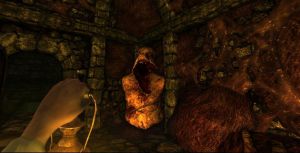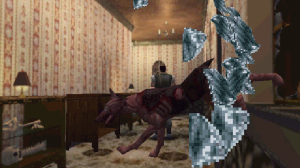What The Player Doesn’t Know
Today I am going to try and organize my thoughts into some quality reading material. I will attempt to keep this rather informative and brief. I think it is rather important to define what haunts a player, and scares a player.
So, lets start out with a definition of both the terms. Lets give Webster’s dictionary a visit.
To Scare: Too frighten; to strike with sudden fear; to alarm.
To Haunt: To frequent; to resort to frequently; to visit pertinaciously or intrusively; to intrude upon.
Looking at both of those definitions, we can fairly say that a scare is a temporary feeling when you are made aware of something unexpected. A scary feeling can also be created when you know what something has done/could do and you feel threatened because of this. Lets take a look into some games of the past to get a good feeling of what has been scary.
Ahhh, the famous dog scene in Resident Evil. When the player reached a certain area in the hallway the dog jumps out of the window in front of the camera, and the player is often startled by this event.
Why did the player get startled when this happened? Well up until this point the player has never encountered a dog. Sure the player saw them earlier in the game with the cinematic, but the player knew they
would not be interacting with the dog at that moment. However when the dog jumps through the window the player panics. The player had thought all they had to worry about was zombies, because the dogs were outside. No windows had been broken either, so the player felt comfortable being around windows without the fear of them being broken. But when all of this happened, it broke all the rules that were established sub consciously in the players head. (The windows wont be broken, the dogs will stay outside).”
To wrap it all up, if the player feels comfortable, break what they “know” about the game. Essentially this is how players are scared in games. If you keep breaking the rules it will always keep the players anxiety level up and open the door into fear.
 Lets open door into another game, a fairly recent one, Amnesia: The Dark Descent. This game thrives on building up the anxiety of the player. While this game does not have much for quick snappy scares it uses tension and anxiety built up in the player over time to create something that haunts the player. Frictional Games (the developers) use sounds, visuals and other clever techniques to build up this anxiety within the player. Its not until rather far in the game that you even encounter something that can know harm you. But until that point the player does not know this. The player does not what an enemy looks like, when its going to show up, what it does. They know nothing. This only amplifies the tension brought out by the sounds, visuals etc. If you give the player no knowledge of monster in a horror game they are forced to create one by themselves. Welcome to the imagination.
Lets open door into another game, a fairly recent one, Amnesia: The Dark Descent. This game thrives on building up the anxiety of the player. While this game does not have much for quick snappy scares it uses tension and anxiety built up in the player over time to create something that haunts the player. Frictional Games (the developers) use sounds, visuals and other clever techniques to build up this anxiety within the player. Its not until rather far in the game that you even encounter something that can know harm you. But until that point the player does not know this. The player does not what an enemy looks like, when its going to show up, what it does. They know nothing. This only amplifies the tension brought out by the sounds, visuals etc. If you give the player no knowledge of monster in a horror game they are forced to create one by themselves. Welcome to the imagination.
The imagination is more powerful then anything we can do in any game to create fear in a person. This is what makes Amnesia: The Dark Descent so powerful and what makes it so widely talked about as one of the most scary games. Because every person has their own fears and their own definition of scary its best to leave it up to themselves to define scary. So the longer we don’t show an enemy the more time it gives the player to “create” the scary enemy. The player will then “see” things in the darkness and build up that ever important tension. Often times the player will get a jump scare from the simple things in games this way. Can you remember a time when you made a noise or took some damage from something and you jumped? But nothing was there at all?
Its easy to scare players when they don’t know what’s around the corner or behind that door. But does that leave a lasting impression on the game? Will players remember a game strictly of just jump scares? If we can get the player to build up fear and haunt them more then we scare them the scary moments will have more of a lasting impact. Additionally the game will be mentioned as one the scarier games of the most generation. If we can create lasting moments of horror and tension we can let the players imagination take over. When the imagination takes over we can then limit scary scripting sequences and just rely on the environments.
Curtis Zhelus – Level Design for Solarix














